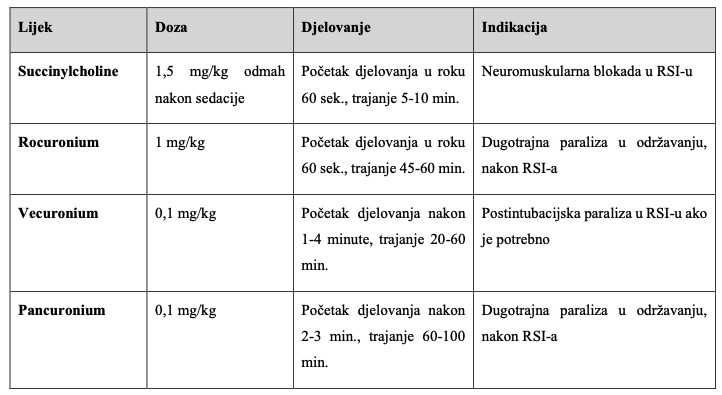The sedative is applied before the neuromuscular blocker. Although they can be given simultaneously, it can be stressful and frightening for the patient to be aware until they are able to breathe spontaneously due to relaxation of the airway muscles.

Etomidate is a fast-acting, short-acting nonsteroidal hypnotic sedative that has been used for induction of anesthesia for many years. It can be the drug of choice for hypotensive or traumatized patients. It reduces intracranial pressure, blood flow in the brain and oxygen metabolism in the brain. A single dose can reduce cortisol levels.
Ketamine, often described as a dissociative anesthetic, is a neuroleptic. It increases cardiac output, blood pressure, blood flow in the brain, heart rate, oxygen consumption in the heart and causes the release of endogenous catecholamines. It increases bronchial and salivary secretion, which can be reduced by using Atropine in a premedication dose of 0.01 mg/kg of body weight. Ketamine can cause hallucinations upon awakening, which can be unpleasant for adults and occurs in approximately 50% of cases, while in children it occurs in less than 10% of cases.
Midazolam is a short-acting benzodiazepine with a duration of 30 to 60 minutes and a slower onset of action. Sometimes the full effect may take 3-5 minutes to appear. Causes respiratory and cardiovascular system depression.
Propofol is a sedative used relatively recently for induction. It has a very fast onset of action within 10-20 seconds and a short duration of 10-15 minutes.
For neuromuscular blockade, i.e. paralysis, the drug of choice should have a rapid onset of action, a duration that is proportional to the administered dose, and should possess sedative, analgesic and amnestic properties. The preferred drug should also be safe to use regardless of the patient’s age, with minimal or no side effects.

Neuromuscular blocking agents currently available can be classified as depolarizing (succinylcholine) or nonphysiological depolarizing drugs (pancuronium, rocuronium, vecuronium, etc.).
In the Rapid Sequential Intubation (RSI) procedure, once everything is ready and the patient is oxygenated, a sedative is administered. The choice of sedative is determined by the doctor based on the clinical condition of the patient and the properties of the drug.
When the sedative kicks in and the patient loses consciousness, pressure is applied to the thyroid cartilage (the Sellick maneuver), and this pressure is maintained while the endotracheal tube is placed and the cuff is inflated, ensuring a patent airway.
The neuromuscular blocker is administered immediately after sedation, and when it begins to work, the patient is intubated, the position of the endotracheal tube is checked, and the tube is fixed in place.



0 Comments